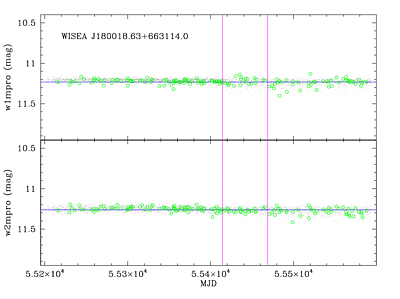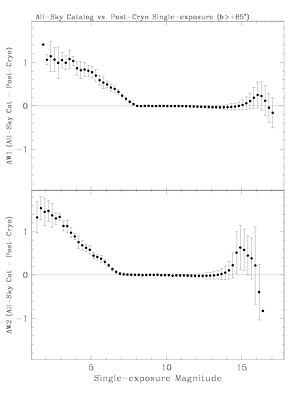


III. AllWISE Multiepoch Photometry (MEP) Database
III.2. Cautionary Notes
III.2.a. Database Content and Usage
- The MEP Database contains multiple, independent,
time-tagged measurements made on the individual Single-exposure
images for each deep-detection source entry
in the AllWISE Source Catalog and Reject Table.
The AllWISE MEP Database is a resource to explore the flux history
of the objects found in the Catalog/Reject Table. It is not
a catalog in the traditional sense of having one entry per object
on the sky. The best way to use the MEP DB is to extract light
curves of specific objects found in the Catalog or Reject Table
using the unique identifiers
source_id_mf,
cntr_mf or
Catalog/Reject Table equatorial position, rather than to make large
area or statistical searches.
-
Not all possible Single-exposure measurements for an object may
be in the MEP Database.
The MEP Database contains the Single-exposure flux measurements made on
all framesets that were used in AllWISE Multiframe Processing.
However, not all Single-exposure framesets were used in
AllWISE processing, as described in V.1.b.
Framesets that were evaluated to be of degraded quality or contained a
large fraction of outlier pixels due to scattered light or other
transient events, were omitted. W3 frames from the 3-Band Cryo phase
were not used because of their greatly reduced sensitivity and highly
variable calibration. The largest set of otherwise good quality measurements
excluded from the MEP Database are those in the 73 Tiles near the
ecliptic poles for which coverage was
attenuated in AllWISE Multiframe processing.
An example of this shown in Figure 1 which contains W1 and W2 light curves
of a source near the north ecliptic pole that was observed
over 5700 times during all WISE survey phases. The MEP Database
contains a sparsely sampled light curve of 145 measurements for
this object.
All of the source extractions made on the Single-exposures
during Scan/frame Pipeline processing,
regardless of quality, can be found in the individual
All-Sky,
3-Band and
Post-Cryo
Release Single-exposure Source Working Databases. However, please
read the Cautionary Notes about using
the Single-exposure Working Database photometry.
 |
| Figure 1 - W1 (top) and W2 (bottom) light curves
for WISEA J180018.63+663114.0. This source lies very close to the
north ecliptic pole and was imaged 5751 times by WISE. The small
black dots are the 5520 (quality>0) individual photometric measurements
available from the WISE All-Sky, 3-Band Cryo and NEOWISE Post-Cryo
Single-exposure Working Databases. The green circles are
the 145 Single-exposure photometric measurements available in the
MEP Database. |
- Not all MEP Database entries will have flux measurements
in all four WISE bands
In cases where Single-exposures in some WISE bands were not utilized
in AllWISE Multiframe processing, the flux measurement values in
those bands in the MEP Database will be null. This
is most common for the W3 and W4 entries from 3-Band Cryo and Post-Cryo
Single-exposures, and from 4-Band Cryo framesets that were taken
within 2000 sec after the Si:As detectors were
annealed.
- The MEP Database contains duplicate, redundant sets of
measurements of the some objects.
As described in V.4, objects in
the overlap region between Tiles or that are part of
small-separation, same-Tile duplicate groups, may have been detected and
extracted more than once during AllWISE Multiframe processing.
All of the deep source extractions of these duplicate objects
will have corresponding sets of photometry in the MEP Database.
Because these sources are measured on the same sets of Single-exposures
in all cases, the duplicated flux measurements in the MEP Database
are redundant. Redundant, duplicate sources were
identified and excluded from the AllWISE
Catalog, but they remain in the MEP Database. The best way
to distinguish between MEP Database entries corresponding to
Catalog objects from those in Reject Table is via their
unique identifiers,
source_id_mf and
cntr_mf.
III.2.b. MEP Database Photometry
- The W1 and/or W2 fluxes in the MEP Database for sources
that are brighter than W1<8 mag and W2< 7 mag are systematically
brighter in the Post-Cryo Single-exposure measurements than
in the 4-Band and 3-Band Cryo measurements
As described in
section VIII.3.e.iv of the NEOWISE Post-Cryo Release
Explanatory Supplement,
the Post-Cryo W1 and W2 profile-fit flux measurements of
sources become systematically brighter than those the measurements
of the same sources on 4-Band and 3-Band Cryo phase images beginning
at the nominal saturation limits of W1<8 and W2<7 mag. This bias
is illustrated in Figure 2. The systematic
differences between Cryo and Post-Cryo Single-exposure measurements
can give a false indication of flux variability. For this reason,
the Post-Cryo Single-exposure measurements for sources brighter
than the saturation limit are excluded from the
flux distribution statistics that are accumulated for the deep source
detections in the Catalog and Reject Table
(V.3.b.v), and therefore are not used
in the computation of the variability flag for those objects.
The Post-Cryo flux measurements of saturated W1 and W2 sources
are in the MEP Database, though, so use care when analyzing light
curves for these sources.
 |
| Figure 2 - The trimmed average differences in 0.25
mag bins between W1 (top panel) and W2 (bottom panel) profile-fit magnitudes
of sources within five degrees of the north Galactic pole from the All-Sky
Release Catalog and the Post-Cryo Single-exposure Source DB plotted as a
function of Single-exposure magnitude. The error bars are the RMS of the
trimmed distributions in each magnitude bin. The red horizontal line
denotes the zero level. The upturn near W1~8 and W2~7 mag
where Post-Cryo measurements become systematically brighter than
All-Sky Catalog measurements occurs at the onset of saturation. |
- The flux measurements for a significant fraction of the MEP
Database entries may be non-detections (e.g.SNR<2)
The MEP Database contains the Single-exposure measurements for
each source that was detected on the deep, coadded Atlas Images.
Because the majority of the deep detections in the AllWISE Catalog
and Reject Table are fainter than
the Single-exposure sensitivity limits, their entries
in the MEP Database will correspond to non-detections.
Nonetheless, the instrumental flux measurements and uncertainties
are available for the Single-exposure measurements. Note that when
a Single-exposure flux measurement has SNR<2, the corresponding
Single-exposure magnitude,
w?mpro_ep,
is computed from the 95% confidence flux upper limit and the
magnitude uncertainty,
w?sigmpro_ep,
is null.
- Flux uncertainties for some MEP Database measurements
may be unphysically large
Extremely large profile-fit flux uncertainties,
w?sigflux_ep, for some
Single-exposure measurement in the MEP Database sometimes
occur if the Single-exposure source images are contaminated by cosmic rays,
scattered light or image artifacts, or only a small number of unmasked
pixels are available for a fit. Be aware of these large uncertainties
and exclude the corresponding fluxes in your analyses.
- Individual Single-exposure measurements are susceptible to
contamination from transient events.
Although Single-exposure framesets of low quality were omitted
from AllWISE Multiframe processing, measurements on any individual
Single-exposure can still be contaminated or biased by charged
particle strikes or scattered light from the moon. Several frameset
quality metadata parameters are included in each MEP Database entry that
can assist in identifying measurements that may be affected.
- qi_fact - Frameset image
quality score. The most severe cases of Single-exposures with smeared
images were excluded from AllWISE processing. However, limit entries to
those with qi_fact=1 to avoid cases were low level smearing
may lead a slight phtometric bias.
- saa_sep - Angular distance from
the nominal boundaries of the South Atlantic Anomaly (SAA). Select
database extractions with saa_sep>0 to avoid extractions
from framesets taken when the WISE spacecraft was within the boundaries
of the SAA, and thus may exhibit elevated levels of radiation hits in the
image data.
- moon_masked - Moon masking
flag. This
is a four character flag, one character per band, that indicates if the
frameset falls within an area covered by the
mask of scattered moonlight. Select
database entries where moon_masked=0 to avoid extractions that
are made on
frames that may be contaminated by scattered light from the moon.
- Sources that are extended, confused with nearby objects, or
contaminated by image artifacts may have a large scatter in their
MEP Database fluxes
The intrinsic scatter in Single-exposure profile-fit photometric
measurements can be larger than expected from the nominal brightness
of the source for objects that are saturated, extended, blended or
confused with nearby objects, or that are affected by image artifacts
from bright stars.
The elevated scatter in repeated measurements in these
cases can give the false appearance of flux variability. Use care
when analyzing MEP Database light curves of Catalog/Reject Table
entries that have
w?sat>0.01,
ext_flg>0,
nb>>1 or
na>0, or
cc_flags=[DHOP] in any band.
III.2.c. Positions in the MEP Database
- The MEP Database entries contain the position of the deep source
detection in the Source Catalog or Reject Table
The ra and
dec coordinates
in each MEP Database entry are those of the corresponding deep source
extraction in the Catalog or Reject Table. Positions are not re-derived
for the profile-fit measurements on the individual Single-exposures
during the AllWISE Multiframe processing.
For sources that are bright enough to have been detected on the
Single-exposure images, positions derived from the individual images are
available from the
All-Sky,
3-Band and
Post-Cryo Release
Single-exposure Source Working Databases.
Last Updated: 19 November 2013







